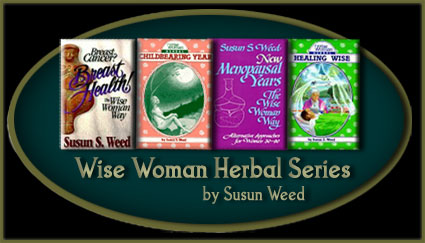Chickweed: My favorite salad green
by Corinna Wood
Director of Red Moon Herbs
The fruit trees are blooming, the birds are back, the sun is rising earlier each day, and it's time to start clearing a space for this year's garden. 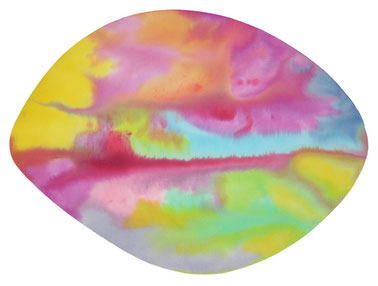 But it goes without saying that the weeds will already have gotten the jump on you.
But it goes without saying that the weeds will already have gotten the jump on you.
"If you can't beat 'em, join 'em," the saying goes. But in this case, a more apt formulation might be, "If you can't beat 'em, eat 'em!" And before you start clearing out those weeds, remember that, unbeknownst to you, your garden may already be producing gourmet salad greens.
You've probably seen peppercress, a wild mustard green that's related to broccoli, with its four tiny white petals on each flower. Dandelion is just opening its sunshine flowers about now. And then there's plantain, whose parallel veins run up the bright green leaves.
All of these can be eaten or made into medicine. But if you're lucky, chickweed (known to botanists as Stellaria media) will have made itself at home in your garden beds by now. And in spring, chickweed's "star in the middle" shows white and bright.
If you're not sure that what you have is chickweed, look for a line of hairs running along just one side of the stem. (The star lady's hairs are tiny, so you may need a magnifying glass for this.) Of course, it's imperative to positively identify any wild edibles before chowing down. And when in doubt, consult one who knows.
Chickweed is my favorite salad green. It tastes just the way it looks: mild, gentle and bright green! As a friend of mine says, "Eating a chickweed salad makes me happy -- I find myself laughing out loud."
And if you're someone who eats by the numbers, note that chickweed is loaded with calcium, potassium, iron, phosphorus, manganese, vitamin C, B vitamins and even protein.
Chickweed, used in many herbal weight-loss formulas, also contains saponins (soapy substances that help dissolve unneeded fat cells). Wild foods in general give our bodies the exact balance of nutrients that we evolved to eat. And with optimum nourishment, we're less likely to crave empty calories.
When this versatile green is in season, my chickweed rice salad is always a big hit. Just mix equal parts chopped chickweed and cooked rice, then stir in some olive oil, minced garlic and salt to taste. It's even more delicious with chopped walnuts and crumbled feta cheese.
Another great way to introduce your friends and family to chickweed is the BCT (bacon, chickweed and tomato sandwich). Chickweed also works well in pasta salads, omelets and potato salads.
The easiest way to harvest chickweed is with scissors, as if you were giving it a haircut (leave the lower portion of the plant so it can continue producing). Chickweed often shares space with one of several wild mints, which are harmless but taste pretty bad. Watch what you're doing, so you don't mix in dirty, old or brown chickweed, or other plants you can't identify.
By harvesting in this meditative way, when I bring home my basket of chickweed, I don't need to wash or pick through it -- it can go straight into the salad bowl. Chickweed's my gourmet guru!
Chickweed loves cool, wet weather, so it becomes lush in spring and fall. But for most of the 10 years that I've lived in these mountains, I've harvested chickweed all winter long -- often brushing snow aside to get at the plants! It shrinks down in response to the cold, with small, thick leaves, but it's still delicious and good for you.
In summer, chickweed dies down to a brown, stringy mat, its seeds packed into beak-shaped pods. That's the time to plant it in your own garden.
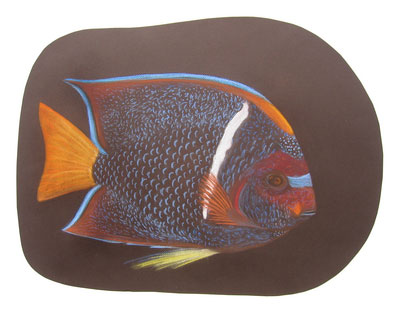 Many gardeners curse chickweed, but by learning to work with it, many farmers and gardeners have found that it can make a wonderful cover crop, as an alternative to bare soil or mulching. Because it's low-growing, it doesn't compete with taller plants for sunlight. And since the roots are shallow, it's easy to pull out when it gets in the way.
Many gardeners curse chickweed, but by learning to work with it, many farmers and gardeners have found that it can make a wonderful cover crop, as an alternative to bare soil or mulching. Because it's low-growing, it doesn't compete with taller plants for sunlight. And since the roots are shallow, it's easy to pull out when it gets in the way.
When I started my last garden, I wanted to encourage chickweed as a companion to my vegetables. In the early summer, I found a patch of chickweed (by then just a brown mat loaded with seeds), put a bunch of this plant material into a plastic bag, and brought it home, where I -- God forbid -- spread it across my garden beds.
When the cool rains began that fall, we were delighted to see the chickweed germinate. For years now, that same patch has blessed my family and me with an abundant supply of lush chickweed. Most years, in fact, we eat more chickweed than any other green from our garden.
Besides gourmet wild salads, you can also make your own herbal medicines from this valuable "weed." Using chickweed from your back yard, it's easy to make a vinegar, tincture or poultice.
An organic farmer friend of ours called last week to say, "The chickweed is taking over here! I'll be plowing in a few days. Can you come get it first?" We packed up our scissors, jars, organic raw apple-cider vinegar and 100 proof alcohol and headed out for the year's first herbal-medicine harvest.
The poultice is also used to heal rashes, cuts, itches and infections. It has a particular affinity for the eyes, as my friend Pam and her son Zed discovered.
At age 4, Zed was having recurrent bouts of conjunctivitis. Each time, Pam would take him to their doctor, who would prescribe antibiotics. The infection would go away for a few weeks, only to come back with a vengeance. By the time Pam heard about chickweed, she was willing to try anything.
The next time Zed woke up with his eyes sealed shut with pus, she crushed a handful of chickweed leaves from their garden and placed it gently on his closed lids, letting him know that this was to help his eyes heal. She then placed a warm, wet washcloth on top.
"That feels really good, Mom," said Zed. After 10 minutes, she removed the poultice, was able to wipe away the pus, and Zed opened his puffy eyes.
Looking at the chickweed at his bedside, he said: "Mom! That's the star-flower plant that's by my favorite rock! Can we do that again?" They used poultices of chickweed several times a day for the next few days, and the infection healed faster than it ever had with antibiotics. More importantly, it stayed clear -- for many months.
When it finally did come back, Zed went out to collect his plant ally himself. He's had no more conjunctivitis ever since.
So the next time the chickweed gets the jump on you, consider it not a curse but a thank-you gift from Mother Earth for creating a fertile piece of ground.
Making a Chickweed Tincture
To make a tincture, simply stuff a jar full of freshly harvested chickweed and then fill the jar with alcohol. Cap it and let it sit for six weeks, then strain out and compost the plant material. (To make vinegar, just substitute vinegar for the alcohol.)
Store the tincture in a brown dropper bottle, taking 25-50 drops at a time. Chickweed tincture has traditionally been used to nourish the kidneys, bladder and liver, as well as for irritated skin conditions and cooling the body during fevers or hot flashes.
Keep the mineral-rich vinegar on your kitchen table; it makes a tasty seasoning on cooked greens or in homemade salad dressings and marinades.
 Corinna Wood is the director of Red Moon Herbs, making herbal medicines from fresh, local plants, with a focus on women's health, for over ten years. A gifted teacher and powerful visionary, Corinna has opened the hearts of thousands to the wisdom of the plants and their own bodies. Corinna's background includes an extensive apprenticeship with Susun Weed in 1993 as well as a B.S. in Biology. Corinna is certified as an herbalist, a fertility awareness teacher, and also in permaculture design.
Corinna Wood is the director of Red Moon Herbs, making herbal medicines from fresh, local plants, with a focus on women's health, for over ten years. A gifted teacher and powerful visionary, Corinna has opened the hearts of thousands to the wisdom of the plants and their own bodies. Corinna's background includes an extensive apprenticeship with Susun Weed in 1993 as well as a B.S. in Biology. Corinna is certified as an herbalist, a fertility awareness teacher, and also in permaculture design.
You are invited to attend Corinna's classes - see Classes Overview page for current opportunities to study with Corinna.
Red Moon Herbs' Chickweed tincture is available on the Tinctures page. To see Red Moon Herbs products, click here.

Nourishing
Traditions
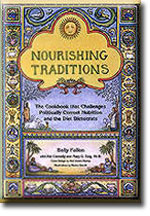 The Cookbook that Challenges Politically
Correct Nutrition and the Diet Dictocrats.
The Cookbook that Challenges Politically
Correct Nutrition and the Diet Dictocrats.
Revised Second Edition, October 2000
by Sally Fallon with Mary G Enig, PhD
This well-researched, thought-provoking guide to
traditional foods contains a startling message: Animal fats and
cholesterol are not villains but vital factors in the diet, necessary
for normal growth, proper funciton of the brain and nervous system,
protection from disease and optimum energy levels. Sally Fallon
dispels the myths of the current low-fat fad in this practical,
entertaining guide to a can-do diet that is both nutritious and
delicious.
Order
Sally Fallon's book at our bookshop
Or order via mail: Ash Tree Publishing PO Box 64 Woodstock,
NY 12498
include a check or money order for $29.95 (Nourishing Traditions
retails for $25.00 plus $4.95 shipping

Opening Our Wild Hearts to the Healing Herbs
 by Gail Faith Edwards.Gail is an herbalist with thirty years experience serving her rural Maine community, founder of Blessed Maine Herb Farm. Information on 125 herbs
and trees. Directions for growing, harvesting, drying, processing
and storing, and lots of uses. Introduction by Susun Weed. 256 pages,
index, illustrations.
by Gail Faith Edwards.Gail is an herbalist with thirty years experience serving her rural Maine community, founder of Blessed Maine Herb Farm. Information on 125 herbs
and trees. Directions for growing, harvesting, drying, processing
and storing, and lots of uses. Introduction by Susun Weed. 256 pages,
index, illustrations.
Read an exerpt Herbs
and Spirit Power
Read a review
Order Opening Our Wild Hearts in our Bookshop
"A jewel written by an accomplished herbalist, the graceful flow of words makes the reading of this book like smooth honey to the soul."
Rosemary Gladstar, Herbal Healing for Women

HEALING
WISE: AUDIO CD
HEALING WISE ~ Set Three
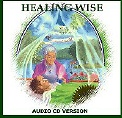
5 CD's
Susun Weed reads aloud - just for you - her alternative medicine
classic Healing Wise. Her wise observations and warm voice
add special savor to a rich and satisfying feast of ideas
about health and healing.
|
CD 1
Nettle Recipes
Oatstraw Speaks
Oatstraw Uses
Oatstraw Recipes
|
CD 4
Herbal Pharmacy, part 2
Buying Herbs
Making Herbal Infusions, Decoctions, & Syrups |
CD 2
Seaweed, Come Dance with Me
Seaweed Walk
Seaweed Properties and Uses
Violet Speaks |
CD 5
Making Herbal Tinctures and Vinegars
Making Herbal Oils |
CD 3
Violet Facts and Weedwalk
Violet Leaf: Properties and Uses
Violet Flowers and Fruit
Herbal Pharmacy, part 1 |
|
Buy this wonderful CD Collection in our Bookshop




 Corinna Wood is the director of Red Moon Herbs, making herbal medicines from fresh, local plants, with a focus on women's health, for over ten years. A gifted teacher and powerful visionary, Corinna has opened the hearts of thousands to the wisdom of the plants and their own bodies. Corinna's background includes an extensive apprenticeship with Susun Weed in 1993 as well as a B.S. in Biology. Corinna is certified as an herbalist, a fertility awareness teacher, and also in permaculture design.
Corinna Wood is the director of Red Moon Herbs, making herbal medicines from fresh, local plants, with a focus on women's health, for over ten years. A gifted teacher and powerful visionary, Corinna has opened the hearts of thousands to the wisdom of the plants and their own bodies. Corinna's background includes an extensive apprenticeship with Susun Weed in 1993 as well as a B.S. in Biology. Corinna is certified as an herbalist, a fertility awareness teacher, and also in permaculture design. 


